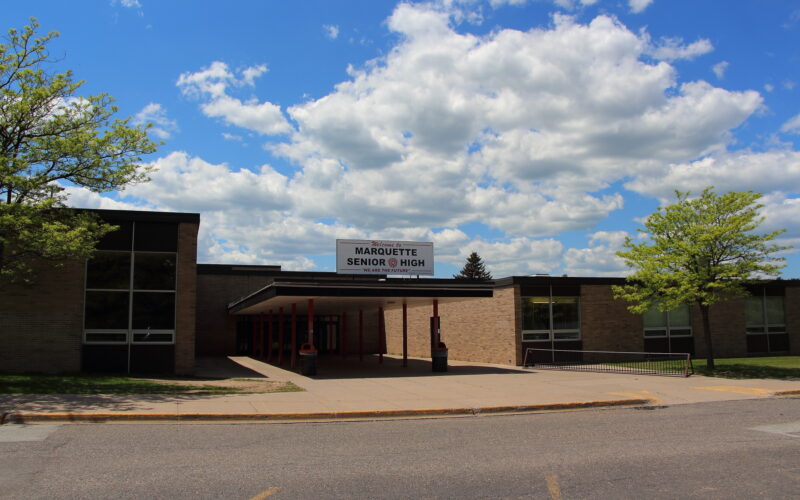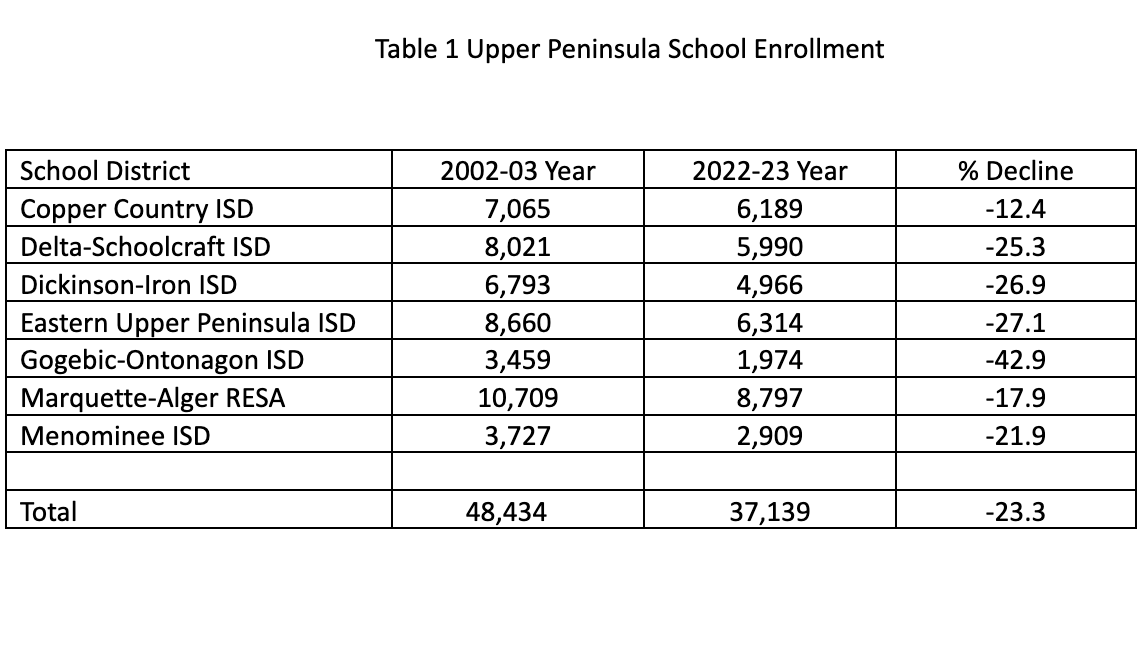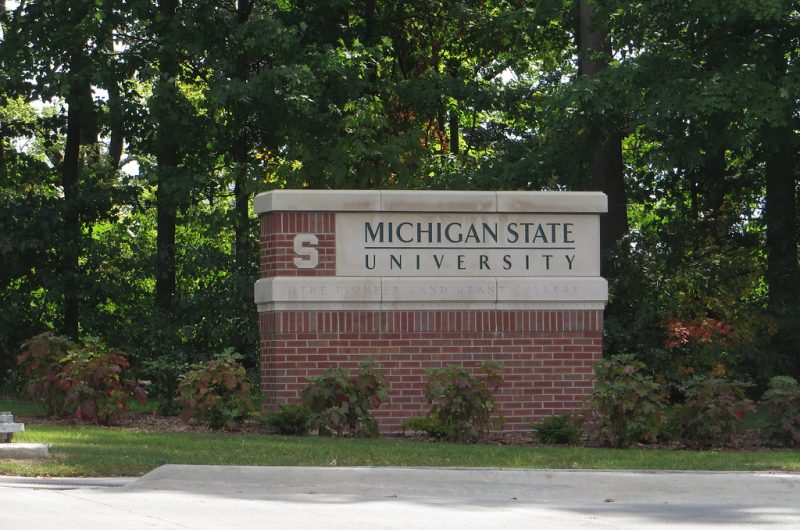Demography is Destiny? The Implications of Declining School Enrollment for the Upper Peninsula

‘Demography is Destiny’ is a phrase attributed to Auguste Comte, a French nineteenth-century philosopher, who argued that the size and structure of a population will influence its future.
His idea was perfectly illustrated when as a Northern Michigan University administrator I listened to a presentation about the enrollment challenges confronting the University due to the state’s shrinking population of 18-year-olds. The presenter analyzed the population of Michigan students in each grade (K thru 12) and noted that the numbers in the early grades were lower than the higher grades, ensuring that in the future there would be fewer College eligible students.
Since that presentation, the number of births in the state has continued to fall, from 117,309 in 2009 to 105,022 in 2021. This drop is part of a long-term decline in US birth rates, which since 2010 have fallen below the so-called replacement level–the level at which a population replaces itself from one generation to the next. The only factor stopping the US population from declining is immigration.
This article begins by analyzing the drop in school enrollment in the Upper Peninsula, considers some of the consequences of this decline, and suggests what might be done to address this issue.
Upper Peninsula School Enrollment
According to MI school data, the seven UP school districts had a total enrollment of 48,434 in the 2002-03 school year. Twenty years later, the number had dropped to 37,139, a 23-percent decline. The largest loss is associated with schools in the western UP (Gogebic and Ontonagon counties), while the Copper Country School District that serves Keweenaw, Houghton and Baraga counties had the smallest decline (Table 1).
Despite the overall decline, there are significant variations in enrollment within each school district. In Marquette-Alger, the number of students attending Munising public schools has fallen from 950 to 570 over the past twenty years. In contrast, the corresponding figures for the Marquette area public schools are 3,720 and 3,233. Despite this caveat, the fall in school enrollment is unequivocal and there is little evidence to suggest that this situation is likely to change any time soon.
Consequences of Declining School Enrollment
One obvious consequence of falling school enrollment is a similar drop in postsecondary education enrollment. For Northern Michigan University (NMU), which has historically depended upon UP students for a significant proportion of its enrollment, the effects are clear.
According to the Michigan House Fiscal Agency, the number of Fiscal Year Equated Students (a calculated statistic used to determine the number of full-time students at each Michigan public university) at NMU fell from 8,568 in 2011-12 to 6,374 in 2021, a decline of more than 25 percent. At Lake Superior State the drop was even larger at 40%. In contrast, Michigan Tech was one of only three state universities that experienced an increase in Fiscal Year Equated Students (+4%), the others being Michigan State (+6%) and the University of Michigan at Ann Arbor (+19%).
Declining enrollment brings a host of challenges for universities. They have fixed costs such as payroll, heating, and maintenance which have to be met, while their ability to meet these costs is constrained by limits on tuition increases and falling enrollment. This means they scramble to cut costs by not replacing retiring faculty and staff, or encouraging faculty to leave through buy-out programs. Simultaneously, they look for alternative revenue sources by expanding online graduate programs where higher tuition rates can be charged, and targeting so-called non-traditional students.
At a community level, falling enrollment has economic implications, since fewer students translates into less money circulating locally and fewer parents’ visits. Finlandia University’s recent decision to close illustrates the most dramatic consequence of falling enrollment. That decision will reverberate in Hancock and its surrounding area, with faculty and staff layoffs meaning tough times ahead for businesses that cater to the University’s students and workers.
For the state, fewer students will eventually translate into fewer working adults and taxpayers. At the same time, labor shortages force businesses to increase wages as a means of attracting or retaining workers, leading businesses to pass these increased costs to consumers in the form of higher prices. More significantly from a long-term perspective is the potential reduction in the number of taxpayers.
Michigan has two primary sources of tax revenue: an income tax and a sales tax, with income tax providing the bulk of the state’s revenues. Fewer working adults will mean a reduction in state revenue, unless tax rates are raised, which is an unlikely prospect.
Is Demography Destiny?
Back in the 1960s, demographers were predicting a population apocalypse. Paul Ehrlich, in his book The Population Bomb, famously predicted dire consequences for the world as a result of rapid population growth, most of which have not been borne out. He and others failed to foresee the declining birth rate that has led some countries’ populations to fall.
In the US, a 2021 Pew Research Center survey found that a rising share of U.S. adults who are not already parents say they are unlikely to ever have children, which suggests that the challenges of a declining population are here for the foreseeable future. One means of offsetting population decline is via immigration, the other is attracting internal migrants from other states.
However, the states that continue to experience population gains as a result of migration are in the South and West. Between 2012 and 2021, 177,322 immigrants settled in Michigan, helping to boost the state’s population, (California had the highest figure at 1.9 million). Immigrants are more likely to be of working-age than their U.S.-born counterparts. This means they are more likely to be active in the labor force, allowing them to contribute to the economy not only as consumers but as taxpayers as well. Immigrants are also more likely to establish new businesses than native-born Americans.
In short, encouraging immigrants to settle in Michigan is a means to forge a new destiny, free from the challenges posed by recent demographic trends.







A few things:
1. Why is the focus on “growth” as the solution to every problem? What is wrong with sustaining?
2. Human populations were relatively stable (see link below) until the 1800’s.
https://www.theglobaleducationproject.org/earth/infographics/humanities_population-growth-2020-font.png
3. The population in Marquette has been pretty stable since I moved here 30 years ago. And yet development is moving along at an exponential rate.
4. “Growth” (even without change in population) is altering – and may ultimately destroy – that which so many of us love about the UP – access to nature / outdoor recreation.
5. More and more people have 2 and 3 and 4 “homes” across the country to flit between as weather and mood dictates – that is NOT sustainable. .
6. How about an article looking at solutions that respect sustainable maintenance? Exponential growth will destroy us all.
Excellent comment, Nancy. I agree with you 100%.
The way taxing and funding of public services works in Michigan require growth.
Most Americans no longer can afford children so couples are having less children. The article stated immigration is the only answer but first you must educate our population of ignorant folks. Good luck with that. These are the same folks worried about the border walls, abortion, too many taxes, NIMBY’s, their profound love the former ex-president, racist views by so many, oh did I mention guns more important than saving children lives. Back to immigration the UP should import as many as they can get but getting folks to understand the problem is the greatest obstacle. Iowa is using child labor laws hiring 14 year olds to work, ain’t America great sorry of my sarcasm…
I really appreciate this information and analysis. I think we all understand that population changes occur as a complex result of social and economic changes not only regionally, but also nationally and internationally. It’s important that we take note and form a realistic outlook. I can’t say what preparations and adjustments we’ll need to make in the years ahead but we’ll definitely have to keep an eye on the situation.
Immigration is the key indeed, but without a Congress willing to tackle the issue and come up with a fair and rational immigration program, the situation will linger as it is. Costs of living are the main reason for reduction in childbirth. The outflows to the South and West are partially the result of Boomer retirees moving from colder to warmer climates. They are also spurred by cheaper costs of living in those states (FL, SC, AZ, etc). But the true costs of maintaining lifestyles in these states are skewed by the Federal governments interventions in water supply, disaster relief, and misperception of taxation. (in Minnesota the bottom 20percent by family income pays 8.7% of their income in state and local taxes, in Florida the bottom 20 percent pays nearly 13% of their income in state and local taxes, the top 1% in FL pay only about 2.3 percent , figures from 2018) Climate change will start requiring that the costs in insurance and federal spending be more realistic in regard to other areas, and climate changes (heat, rising oceans, water shortages and frequent excessive storms) will make moving there less attractive. A gradually warmer climate in the Northern USA (hard to believe after this winter) will also help. Short term none of this matters I suppose.
And, geography is destiny, too.
We are entering an era of intractable problems. Nancy’s and Jim’s comments are part of understanding the situation ahead. Managing a growing economy is relatively easy, you can count on revenue and consumption increases to cover the costs of growth. We don’t know how to manage backwards, that is dealing with declining situations. Michigan can’t continue to subsidize the UP at the same levels.
Yoopers already are experts at living with less, but they can’t be expected to cut back more. When times were tough in the past, families moved in together and shared what they had. That’s part of the response we need in the UP — governmentally and economically, that is. Reduce the overlapping units of government, create a UP-wide plan to support essential services. Figure out the limits of tourism and seasonal residency in supporting tax revenues. Concentrate development efforts and revenues on fewer geographic areas (that’s not going to be easy.)
Too few people in the labor force is a choke point in expanding or attracting businesses. That’s where immigration might work, but won’t if immigrants aren’t welcomed. Immigrants come in clusters based on culture and ethnicity, not singly or families. That should be familiar to Yoopers whose families came as thousands of Finns, Italians, Swedes, French Canadians and more during the mining and lumber boom era. Will darker skinned people ever feel welcome in the UP?
Yes, people are piling into sunny, warm, low cost of living states. The southwest water shortages will hit catastrophic conditions soon. The Atlantic and Gulf Coast states’ coastlines will be flooded out over the next 50 years or sooner. Heat bombs will become recurring events. Population growth in those states will eventually reverse as large areas become unsustainable. Federal dollars will flood into those voter-rich areas. There won”t be much left for voter-poor Michigan.
Slow motion crises never get adequate attention. It’s time to change that.
Good piece. The declines in K-12 school enrollments are dramatic and can create a downward loop. The key to the U.P.’s demographic future will be finding ways to retain and attract young adults.
Interesting information. Thanks for presenting this. I think a real mistake, though, is made in focusing only or primarily on post-secondary education. The precipitous decline of a younger generation has huge economic and social consequences that go way beyond higher education. Japan is the extreme example with an aging population with no one to care for or fund their existence. Whole communities are shutting down because there is no one to continue upkeep of the infrastructure. The economy is in collapse because there are no workers to support the growing aging population. Of course our pensions, social security and Medicare depend on a younger and stable or growing younger population to fund them for the older population. The predictions, as to continued funding of these programs, are dire when looking 15 years out. This scenario, again as most seen in Japan, is exacerbated where the seniors are living longer and there is a negative new growth in the population such as there is no one to fund or care for that demographic and economic shift. (Japan further suffers from an aversion to have foreigners help alleviate labor shortages that is even worse than ours.)
Rural populations are hit especially hard. Businesses close or cut back because of the lack of patrons, but most significantly because of the growing scarcity of labor. The UP is much like Japan with an aging population and shrinking workforce. Such prevents development as skilled workers are scarce everywhere, but much less likely to move here or stay here, even if originally from here, The already shrunk population of young people look for the better opportunities in the cities. (BTW, NMU has the highest percent of graduates who move out of the state after graduation of any college or university in this state.) Lots has been written about senior rural areas out east where there is no one to do simple home repair or maintenance for seniors (mow the lawn, rake the leaves, put out the dock, shovel the snow, fix the door lock – you name it. This doesn’t even begin to address the lack of skilled workers to run our industry, build new homes and sustain our infrastructure.) Assisted senior living is especially hard hit. Projections show that the number of seniors who will move into senior housing will increase by something like 100% over the next 15 years (those 80+ will increase by 100%.) During that time, the number of healthcare workers available to work in those facilities and assist seniors will decrease by 50% or more. Already, many senior care facilities cannot take in seniors due to census requirements that staffing be proportionate to residents. Many facilities have the beds, but not the required staff to take in new residents.
All this said, we have had some incredible wins of late to develop and revitalize some key industries in the area. Just look at the Bellerud remachining project, some significant housing developments, some mining developments and growth in tourism. These are huge and will help us immensely over the coming years. They provide stable jobs that promote families, local businesses and foster peripheral growth.
There is also some evidence of a trend that more people want to move to places like the UP to enjoy our nature and get away from the city life, but they want to work from home. This is encouraging, too, but at-home workers do not fix our inhabitants’ plumbing problems, repair the streets or build new homes or care for the elderly.
However, this is a very critical period in much of the advanced world, but especially relevant in rural areas. Growth and sustainability of our industry is essential and efforts in the UP in this regard are promising, but our rural community needs to also focus on that significant nexus between our declining workforce and aging population. We must develop strategies that will allow us to weather this significant trend.
Are home-schooled children included in these numbers? It seems to me, at least in Marquette County, there are a significant number of children who are home-schooled.
Thank you Rural Insights and thank you to the responders. Great conversations.
I understand the conundrum for rural areas like the UP, but the stabilization of population growth in the US and other wealthy nations is good for the long-term survival of humanity when consider our aggregate carbon footprint and the climate catastrophe that is beginning to unfold. The world population has more than doubled since 1969 and though the most dire predictions about population growth may not have been borne out – yet – but there are plenty of terrible results of the rapid growth of humans – numerous wars and other resource-related armed conflicts being the most obvious. Here’s the math – in the last 20 years has increased by roughly 78 million people per year. That is enough new people to populate 10 new metro areas the size of the Chicago metro every year! In the US that has been about 2.7 million per year, enough people for a new Baltimore MSA each year. Population growth is highly variable across the planet, but it is a small planet and we are interconnected more than we tend to think.
The anthropogenic climate change crisis is directly attributable to the expansion of the human enterprise. We are creating unsustainable levels of greenhouse gas emissions for each person in order to:
to grow, harvest, transport, process, and market our food and forest products;
to make, heat, and cool our buildings;
to make, maintain, and fuel our vehicles;
to build and maintain roads, water and sewer, electric and fiber utilities;
to mine raw materials for our roads, utilities, appliances and devices;
other consumer goods manufacturing (diapers-coffins), transport, entertainment; etc.;
managing the pollution that we create;
and the profitable business of war and the defense industry
Pretty much every human in the wealthy nations has a large carbon footprint. Some poorer nations that have high population growth are seeing wealth increase, meaning more consumer goods are being demanded. The population growth rate is too high in some places, not enough to support even a steady-state economy in other places – like much of the UP – but overall humans can’t continue to grow at the levels we’ve been growing without dire consequences, whether those come from climate changes, economic calamities, pandemics, or famines. We are overshooting our ability to support the human enterprise on the whole and that should not be shrugged off because in this part of the world we have a different scenario.